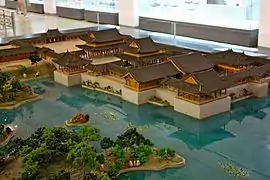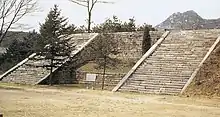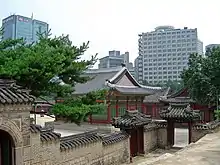
There are a number of palaces in various places in Korea that have been built over the course of several thousand years and several historical monarchies. Many have survived into the present. Some have been destroyed and have since never been rebuilt. And some, such as Gyeongbokgung, have been rebuilt after being destroyed.
Although the palaces of Korea were constructed following ancient Chinese principles, Korea has maintained an independent culture for 2000 years, thus resulting in various differences. Korean people still preserved the original elements of their architecture that show no similarities to China or Japan.[1]
The kingdoms in Korean history built capital cities and palaces starting from 1 BC, but many of their exact forms remain unknown. The palaces of Gojoseon (2333–250 BC) cannot be traced at all. The palaces of the Three Kingdoms can be imagined, mainly from some historical records and sites. The palace of Goguryeo was Anhak Palace, constructed after the capital moved to Pyeongyang, causing a need for a new palace. Thus, in 427 AD, Anhak palace was built. Baekje maintained palaces in Sabi (modern-day Buyeo) and Gongju. Silla had its palace, known as the Banwolseong, within Gyeongju. The Palace of Balhae was said to be Sanggyeong Palace, and was one of the largest palaces in Korean history.
The earliest evidence that shows the concrete Korean architectural style can be explored from the architecture of Gaegyeong, the capital of Goryeo Dynasty.[1] Another palace of Goryeo was Manwoldae.
During the Joseon dynasty, there were eight palaces built, of which Gyeongbokgung, Changdeokgung, Changgyeonggung, Deoksugung, and Gyeonghuigung remain.
 Model reconstruction of the Anapji Pond royal complex, a part of the Banwolseong.
Model reconstruction of the Anapji Pond royal complex, a part of the Banwolseong. Destroyed remnants of the Manwoldae
Destroyed remnants of the Manwoldae The Changdeokgung Palace of the Joseon Dynasty
The Changdeokgung Palace of the Joseon Dynasty Changgyeonggung of the Joseon Dynasty
Changgyeonggung of the Joseon Dynasty Royal architecture in the Deoksu Palace of Joseon.
Royal architecture in the Deoksu Palace of Joseon.